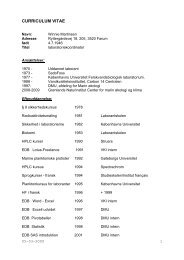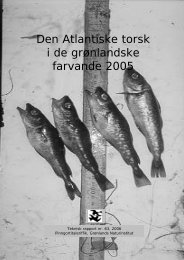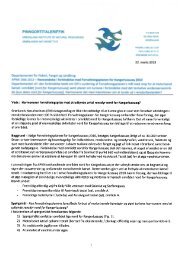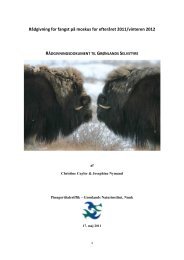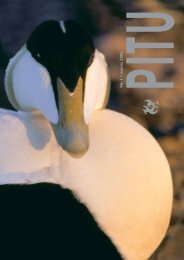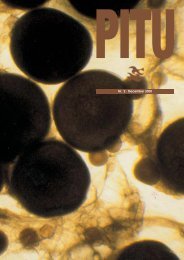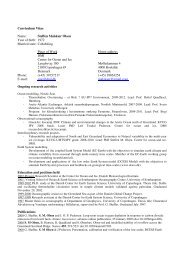Migration and breeding biology of Arctic terns in Greenland
Migration and breeding biology of Arctic terns in Greenland
Migration and breeding biology of Arctic terns in Greenland
Create successful ePaper yourself
Turn your PDF publications into a flip-book with our unique Google optimized e-Paper software.
30<br />
3 Future research<br />
The study on the long-distance migration <strong>of</strong> the <strong>Arctic</strong> tern (Manus I) revealed<br />
a number <strong>of</strong> new facts not previously known about the impressive<br />
annual migration <strong>and</strong> verifi ed exist<strong>in</strong>g knowledge obta<strong>in</strong>ed from r<strong>in</strong>g<strong>in</strong>g<br />
recoveries. This study also raises some new questions that would be <strong>in</strong>terest<strong>in</strong>g<br />
to pursue <strong>in</strong> future studies: 1) at the <strong>breed<strong>in</strong>g</strong> areas, the <strong>Arctic</strong><br />
tern is known to be on the w<strong>in</strong>g most <strong>of</strong> the time. When it rests, it sits<br />
on the ground or alternatively on an iceberg. Unlike most other seabirds,<br />
the <strong>Arctic</strong> tern rarely rests on the water <strong>and</strong> only <strong>in</strong> very calm weather.<br />
The geolocators used <strong>in</strong> the migration study also record dry or wet condition<br />
dur<strong>in</strong>g the period <strong>of</strong> deployment, which can be used to <strong>in</strong>dicate<br />
the <strong>in</strong>dividual’s behaviour dur<strong>in</strong>g migration (Guilford et al. 2009). From<br />
a both physiological <strong>and</strong> energetic perspective it could be <strong>in</strong>terest<strong>in</strong>g to<br />
<strong>in</strong>vestigate whether <strong>Arctic</strong> <strong>terns</strong> manage the long stretches <strong>of</strong> migration<br />
between the polar areas without long periods <strong>of</strong> rest<strong>in</strong>g on the water; 2)<br />
The migration study identifi ed a divide <strong>in</strong>to two different southbound<br />
routes. This divide could be co<strong>in</strong>cidental, where w<strong>in</strong>d systems drive the<br />
birds to take a western or eastern route. This would mean that the same<br />
<strong>in</strong>dividual may migrate south by either <strong>of</strong> the two different routes each<br />
year. An alternative explanation would be that the route may be genetically<br />
coded or learned <strong>in</strong> the <strong>in</strong>dividual <strong>and</strong> the same bird will choose the<br />
same route each year. The geolocators have the capacity to log for two<br />
years <strong>and</strong> are cable <strong>of</strong> stor<strong>in</strong>g data for up to ten years. In theory, loggers<br />
applied <strong>in</strong> 2007 <strong>and</strong> not retrieved <strong>in</strong> 2008 (potentially up to 40 loggers)<br />
should conta<strong>in</strong> data on two round trips which could help shed light on<br />
which <strong>of</strong> the two hypotheses is most plausible. An attempt to retrieve loggers<br />
at S<strong>and</strong> Isl<strong>and</strong> was made <strong>in</strong> 2009, but was unsuccessful due to a year<br />
<strong>of</strong> <strong>breed<strong>in</strong>g</strong> failure. Hopefully, an attempt <strong>in</strong> 2010 will prove to have more<br />
success; 3) The migration study identifi ed an area <strong>in</strong> the central part <strong>of</strong> the<br />
Atlantic Ocean to be <strong>of</strong> high importance for the <strong>terns</strong> on their southbound<br />
migration. It seems likely that this area may be important for other surface<br />
feed<strong>in</strong>g seabirds as an at-sea forag<strong>in</strong>g hot-spot, <strong>and</strong> it could be <strong>in</strong>terest<strong>in</strong>g<br />
to exp<strong>and</strong> the number <strong>of</strong> study species <strong>in</strong> a migration study us<strong>in</strong>g geolocators.<br />
Such a study could prove to be an effi cient tool to identify at-sea<br />
areas <strong>of</strong> high biodiversity otherwise diffi cult or cost-prohibitive to obta<strong>in</strong>.<br />
Although the study on relay<strong>in</strong>g <strong>in</strong> <strong>Arctic</strong> <strong>terns</strong> (Manus III) did produce<br />
estimates <strong>of</strong> the species’ ability to produce a replacement clutch when the<br />
fi rst clutch was removed, additional detailed <strong>in</strong>formation is needed <strong>in</strong> order<br />
to address the impact <strong>of</strong> harvest<strong>in</strong>g <strong>and</strong> relay<strong>in</strong>g at the population<br />
level. However, large logistical diffi culties are associated with a study <strong>of</strong><br />
this k<strong>in</strong>d. Relay<strong>in</strong>g <strong>Arctic</strong> <strong>terns</strong> may easily move with<strong>in</strong> or even well out<br />
<strong>of</strong> the colony to place their new nest. The chances <strong>of</strong> detection <strong>of</strong> the new<br />
nest site, <strong>and</strong> establish<strong>in</strong>g an accurate estimate <strong>of</strong> what proportion <strong>of</strong> the<br />
population will relay, decreases with distance from the orig<strong>in</strong>al nest site.<br />
Unless devices, such as radio transmitters, that are able to track the location<br />
<strong>of</strong> the bird <strong>in</strong> a study are used, it will be diffi cult to obta<strong>in</strong> accurate<br />
estimates <strong>of</strong> relay<strong>in</strong>g <strong>in</strong> <strong>Arctic</strong> <strong>terns</strong>.





